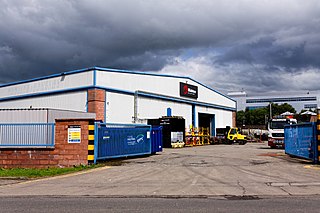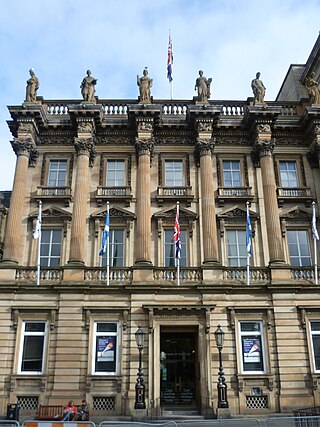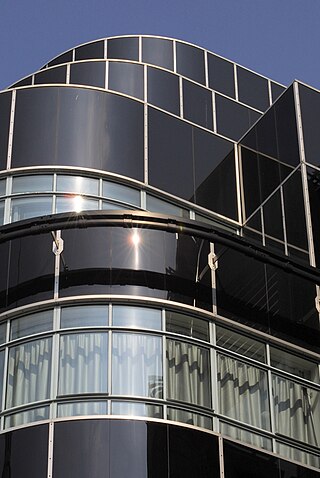
The Bethlehem Steel Corporation was an American steelmaking company headquartered in Bethlehem, Pennsylvania. Until its closure in 2003, it was one of the world's largest steel-producing and shipbuilding companies. At the height of its success and productivity, the company was a symbol of American manufacturing leadership in the world, and its decline and ultimate liquidation in the late 20th century is similarly cited as an example of America's diminished manufacturing leadership. From its founding in 1857 through its 2003 dissolution, Bethlehem Steel's headquarters and primary steel mill manufacturing facilities were based in Bethlehem, Pennsylvania, in the Lehigh Valley region of the United States.
Simpson most often refers to:
The Saffir–Simpson hurricane wind scale (SSHWS) classifies hurricanes—which in the Western Hemisphere are tropical cyclones that exceed the intensities of tropical depressions and tropical storms—into five categories distinguished by the intensities of their sustained winds. This measuring system was formerly known as the Saffir–Simpson hurricane scale, or SSHS.

Alfred Waterhouse was an English architect, particularly associated with the Victorian Gothic Revival architecture, although he designed using other architectural styles as well. He is perhaps best known for his designs for Manchester Town Hall and the Natural History Museum in London, although he also built a wide variety of other buildings throughout the country. Besides his most famous public buildings he designed other town halls, the Manchester Assize buildings—bombed in World War II—and the adjacent Strangeways Prison. He also designed several hospitals, the most architecturally interesting being the Royal Infirmary Liverpool and University College Hospital London. He was particularly active in designing buildings for universities, including both Oxford and Cambridge but also what became Liverpool, Manchester and Leeds universities. He designed many country houses, the most important being Eaton Hall in Cheshire, largely demolished in 1961-63. He designed several bank buildings and offices for insurance companies, most notably the Prudential Assurance Company. Although not a major church designer he produced several notable churches and chapels. He was both a member of The Royal Institute of British Architects, of which he served a term as President, and a Royal Academician, acting as Treasurer for the Royal Academy.

Glued laminated timber, commonly referred to as glulam, is a type of structural engineered wood product constituted by layers of dimensional lumber bonded together with durable, moisture-resistant structural adhesives so that all of the grain runs parallel to the longitudinal axis. In North America, the material providing the laminations is termed laminating stock or lamstock.
Gretsch is an American company that manufactures and markets musical instruments. The company was founded in 1883 in Brooklyn, New York by Friedrich Gretsch, a 27-year-old German immigrant, shortly after his arrival to the United States. Friedrich Gretsch manufactured banjos, tambourines, and drums until his death in 1895. In 1916, his son, Fred Gretsch Sr. moved operations to a larger facility where Gretsch went on to become a prominent manufacturer of American musical instruments. Through the years, Gretsch has manufactured a wide range of instruments, though they currently focus on electric, acoustic and resonator guitars, basses, ukuleles, and drums.

Andrew Barclay Sons & Co., currently operating as Brodie Engineering, is a builder of steam and later fireless and diesel locomotives. The company's history dates to foundation of an engineering workshop in 1840 in Kilmarnock, Scotland.
"Maximum Homerdrive" is the seventeenth episode of the tenth season of the American animated television series The Simpsons. It first aired on Fox in the United States on March 28, 1999. In the episode, Homer challenges trucker Red Barclay to a meat eating contest, of which Barclay is the long-standing champion. Barclay wins but quickly dies of "beef poisoning", marking the first time he will miss a delivery at his job. Feeling bad for him, Homer take on the duty of transporting Barclay's cargo from Springfield to Atlanta.
A tie, strap, tie rod, eyebar, guy-wire, suspension cables, or wire ropes, are examples of linear structural components designed to resist tension. It is the opposite of a strut or column, which is designed to resist compression. Ties may be made of any tension resisting material.

In the manufacture of pharmaceuticals, encapsulation refers to a range of dosage forms—techniques used to enclose medicines—in a relatively stable shell known as a capsule, allowing them to, for example, be taken orally or be used as suppositories. The two main types of capsules are:

A truss connector plate, or gang plate, is a kind of tie. Truss plates are light gauge metal plates used to connect prefabricated light frame wood trusses. They are produced by punching light gauge galvanized steel to create teeth on one side. The teeth are embedded in and hold the wooden frame components to the plate and each other.

Architectural terracotta refers to a fired mixture of clay and water that can be used in a non-structural, semi-structural, or structural capacity on the exterior or interior of a building. Terracotta pottery, as earthenware is called when not used for vessels, is an ancient building material that translates from Latin as "baked earth". Some architectural terracotta is actually stronger than stoneware. It can be unglazed, painted, slip glazed, or glazed. A piece of terracotta is composed of a hollow clay web enclosing a void space or cell. The cell can be installed in compression with mortar or hung with metal anchors; such cells are often partially backfilled with mortar.

The British Linen Bank was a commercial bank based in the United Kingdom. It was acquired by the Bank of Scotland in 1969 and served as the establishment's merchant bank arm from 1977 until 1999.

Pigmented structural glass, also known generically as structural glass and as vitreous marble, and marketed under the names Carrara glass, Sani Onyx, and Vitrolite, among others, is a high-strength, colored glass. Developed in the United States in 1900, it was widely used around the world in the first half of the 20th century in Art Deco and Streamline Moderne buildings. It also found use as a material for signs, tables, and areas requiring a hygienic surface. Over time, the trademarked name "vitrolite" became a generic term for the glass.

The United States Naval Computing Machine Laboratory (NCML) was a highly secret design and manufacturing site for code-breaking machinery located in Building 26 of the National Cash Register (NCR) company in Dayton, Ohio and operated by the United States Navy during World War II. It is now on the List of IEEE Milestones, and one of its machines is on display at the National Cryptologic Museum.
Barclay was an American brand of cigarettes manufactured by R. J. Reynolds Tobacco Company in the United States and by British American Tobacco outside of the United States.

The Braithwaite Burn & Jessop Construction Company Limited is a Public Sector Undertaking (PSU) of the Government of India under Department of Heavy Industries. Established on 26 January 1935, BBJ Construction Company has been involved in the construction & repairing of Rail Bridges & Rail-cum-Road Bridges, Industrial structural works, Large building foundation, Civil engineering works, Refinery piping works, Railway gauge conversion etc. The company is registered and headquartered in Kolkata.
Dataproducts Corporation was an early manufacturer of computer peripheral equipment.

The Simpsons: An Uncensored, Unauthorized History is a non-fiction book about the American animated television series The Simpsons. It was written by John Ortved, and first published in October 2009 by Faber and Faber. In the United Kingdom, the book is called Simpsons Confidential: The uncensored, totally unauthorised history of the world's greatest TV show by the people that made it. The book is an oral history of the show, and concentrates particularly on the writers and producers of the show. The book includes entire chapters devoted to key figures such as creator Matt Groening and James L. Brooks and Sam Simon, who helped develop the series. According to National Public Radio reviewer Linda Holmes, "Ortved's thesis, essentially, is that lots of people are responsible for the success of The Simpsons, and their creator, Matt Groening, has too often been viewed as the sole source to the detriment of others who also deserve to be praised."

Dellner Couplers AB is a Swedish original equipment manufacturer of train connection systems as couplers, gangway systems and dampers. The headquarter of the company is located in Vika in the Falun Municipality. Dellner is owned by the investment organisation EQT Partners and has 19 subsidiaries worldwide with around 1,100 employees. In 2018, the company generated annual sales of around SEK 1.9 billion.













